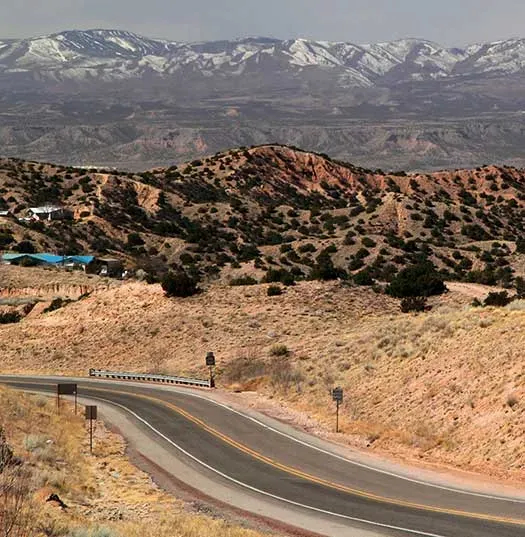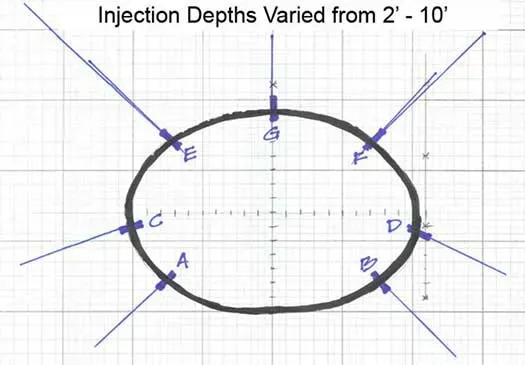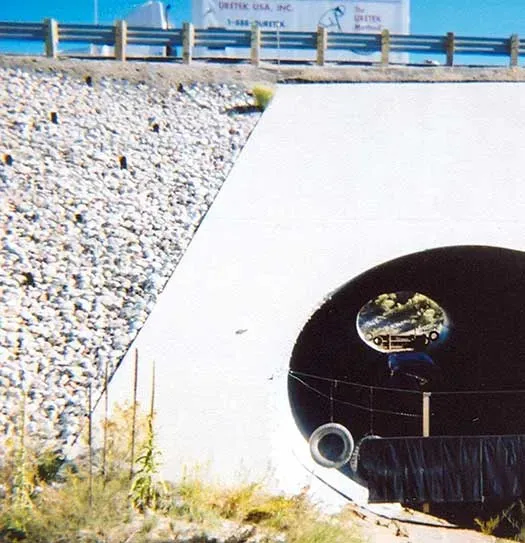State Highway Culvert Roadway Repair in New Mexico
Problem
Four miles north of Cuba, New Mexico, State Highway NM-96 crosses into the Jicarilla Indian Reservation. Where this asphalt road passes over an arroyo, a multi-plate culvert (14 feet tall, 21 feet wide, and 115 feet long) was constructed 22 feet below the road surface to allow spring mountain runoff to drain away. Over time, the roadway above this culvert had settled as much as six inches. In response, the New Mexico Department of Transportation (NMDOT) contracted URETEK to identify weak soil zones between the road and the culvert and around the culvert itself.
Analysis
Dynamic Cone Penetrometer (DCP) tests revealed strong base and sub-base soils above the crown of the culvert, but also revealed poor soil compaction and large, deep voids in several key weight-bearing locations around the culvert. Washout and lost soils often result from fast moving, high volume water flow through a culvert. These weak soils were likely the cause of the roadway settlement.
Solution
NMDOT contracted URETEK to densify these weak soils around the culvert and to lift the asphalt road back to grade. To do this, URETEK chose its URETEK Deep Injection® (UDI) process, a proven technique which provided NMDOT with a long-term solution. UDI is perfectly suited for compromised-soil jobs like these because it utilizes the hydro-insensitive URETEK 486®. The URETEK 486® injections were applied both from the surface-down and radially from inside the culvert running the length of the pipe, (see diagram inset). As the skilled URETEK crews worked their way down the culvert, the polymer expansion strengthened the soils by filling voids and compressing weak areas.
Result
After the last injection of polymer was made and the settled pavement raised back to grade, DCP tests revealed a substantial density increase in the soil above and around the culvert. The entire project required only five working days to complete, and the road remained in service during the entire project! This repaired section of NM-96 remains level to this day, and NMDOT has continued to rely on URETEK to address soil densification and pavement lifting problems across the state.
URETEK Deep Injection® (UDI)
Widely referenced throughout our industry, UDI involves the injection of structural polymer into base and subgrade soils to increase the load bearing capacity. This is achieved by injecting the polymer through small holes drilled directly through the pavement structure to depths determined by site-specific analysis. Our URETEK 486 Star® material flows easily into voids and weak zones within the soil mass below. Through a controlled chemical reaction, the expanding polymer compacts surrounding soils and applies a controlled pressure on targeted areas of the affected pavement above. If needed, a multi-injection design plan is utilized to gently return the pavement to its original grade. The composite material quickly cures into a strong, dimensionally stable, and water-resistant
geo-material, providing years of reliable service.
URETEK 486 Star®
URETEK 486 Star® polymer is a two-component, high-density, expanding thermoset polyurethane system. It was developed to be the ideal solution for under-sealing, void filling, lifting of settled pavement, stabilization and stiffening of weak soils, and for encapsulating and sealing buried infrastructure. URETEK 486 Star® is environmentally inert, non-toxic, and resists underground water erosion or weakening due to its industry-leading hydrophobic properties.


